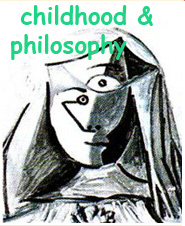the efficacy of the lipmanian approach to teaching philosophy for children
Abstract
How does one best stimulate among children and youth the nurturing of caring, higher order thinking, which Matthew Lipman extols and seeks to realize via his Philosophy for Children program? For Lipman, this is achieved principally through philosophical dialogue in a community of inquiry characterized not so much by participants’ shared quest to reach a fixed destination, but by a process guided by “procedural rules, which are largely logical in nature,” and which are imbued with “reasonableness, creativity, and care”. This, he believes, will best lead to the gaining of a deeper understanding of inquirers’ differing views that in turn enables them to accept and even embrace differences of opinion. Yet, I will contend in this paper, the type of process Lipman espouses, in which one allows an argument to be pursued wherever it happens to lead, must also be somewhat eschewed and supplanted with a discernible method on order to achieve the laudable ends Lipman has in mind, namely of enabling youth to “become more thoughtful, more reflective, more considerate, more reasonable individuals”. To Lipman, an ipso facto outcome of dialogue of the sort he endorses is that as students become inured to asking each other for and seeking out reasons and opinions, they develop the capacity to listen carefully to each other and build upon and develop one another’s ideas; but I will make the case that this skill of careful listening, combined with the development of ideas, needs to be informed by a critical-sceptical method, if the ambitious and laudable democracy-enhancing aims of the Lipmanian Philosophy for Children program are to be optimally achieved. Key words: method; process; community; thinking; rulesDownloads
Published
2011-06-26
How to Cite
phillips, christopher. (2011). the efficacy of the lipmanian approach to teaching philosophy for children. Childhood & Philosophy, 7(13), pp.11–28. Retrieved from https://www.e-publicacoes.uerj.br/childhood/article/view/20576
Issue
Section
articles




